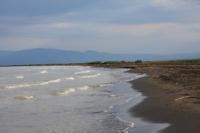Вы здесь
Orography and geology of Alakol reserve.


Bird Watching Tours Alakol reserve.
“Nature is an infinite sphere whose center is everywhere”
Ralph Waldo Emerson.
Phototours to Alakol reserve.
In the northeastern, deepest part of the lake, there is a group of 3 islands, forming the likeness of a small archipelago 17 km long and up to 40 km in circumference. 30 – 40 km from the south, 40–50 km from the west and 14 – 15 km from the north coast.
It is assumed that they are located on the fault line of the earth's crust (Tretyakov, 1960) and represent the outcrops of indigenous Paleozoic rocks of the Middle Devonian and Lower Carboniferous, rising above the surface of the lake in the form of a narrow tectonic block of northwestern strike (Kazan, 1965).
Island elevations with steeply declining terraces of ledges, which are covered with semi-desert vegetation with a predominance of rabbit (Salsola arbuscula), (Nanophyton erinaceum), (Eurotia ceratoides), white earth wormwood (Artemisia terrae-albae), (Kochia scoparia), gray grass and other undeveloped, very stony soils.
The foot of the hills is gravelly pebble with loams and small salt marshes. Along the coast there are shafts of small gravel and pebbles, as well as small lagoon-type bays with open beaches. The configuration of the coastline changes almost annually, since the islands are subjected to the powerful impact of the enormous mass of ice every spring. In the straits between the islands, strong water currents are observed. The islands are a unique nesting place for colonial birds, of particular importance during the years of high water levels on Lake Alakol, when all gulls of birds from flooded small islands along the coast move here.
The main species forming colonies on the islands are laughter, black-headed laughter, cormorant, relict gull, tegrava, tern gull, river tern, magpie sandpiper, small and sea zayka. In summertime, in the bays of the islands, a considerable number of mute swan, big grebe, cinder, some species of other ducks and waders concentrate on molting.
Due to the fact that fishing in the water area of the lake was intensively carried out by fishing teams of the Alakol fish factory (created in 1939), the islands often, especially in stormy weather, moored boats, boats and large transport vessels that were created for breeding colonies in the nesting period birds are a serious factor of concern.
Fishermen's arrivals were especially fatal for relic gulls, which, unlike other gulls, throw masonry even after a single visit by people. Along with random visits, groups of local residents came to the islands specially, who from year to year they prepared eggs of gulls and terns, as well as cormorant chicks, often destroying the entire colony.
Hydrology of the Alakol reserve.
The basin of Lake Alakol covers an area of 68,700 square kilometers. The main part of which (48,600 km) is located within Kazakhstan, the rest (30%) - in the border regions of China. Most of the basin (56%) is represented by a desert plain, the lower part of which is occupied by a group of lakes: Alakol (2650 km), Sasykkol (736 km), Uyaly (120 km), Zhalanshkol (38 km), which form an extensive system of wetlands with reed beds (1100 km), among which there are more than 100 small lakes with an area of 0.5 to 600 ha.
The first three lakes are interconnected by channels and canals. On the isthmus between Alakol and Koshkarkol there are 2 swampy lakes - Korzhinkol and Beskaska.
Authority:
Berezovikov Nikolay Nikolaevich, Cand.Biol.Sci.
Photos
Alexander Petrov.







